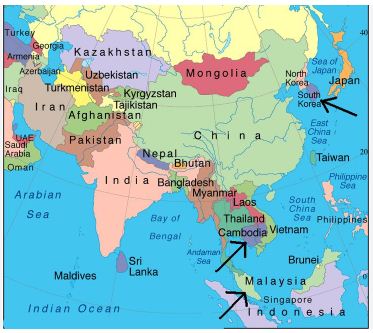July 25, 2025
UPSC Daily Current Affairs- 25 July 2025/Thailand-Cambodia Border Conflict 2025: Reasons and Historical Context
Why in the News?
- On July 24, 2025, Thailand and Cambodia engaged in deadly clashes along their 800-km border, marking a significant escalation in their longstanding territorial dispute. The conflict resulted in at least 11 deaths, mostly civilians, with Thai forces launching airstrikes on Cambodian military targets and both sides exchanging small arms, artillery, and rocket fire.
- The violence prompted Thailand to close all land border crossings, recall its ambassador, and expel Cambodia’s ambassador. Videos showed Thai villagers fleeing to concrete bunkers amid explosions, and over 138,000 Thai and 20,000 Cambodian civilians were evacuated from border areas. Cambodia’s Prime Minister Hun Manet requested an urgent UN Security Council meeting, accusing Thailand of aggression. The clashes, centered around disputed areas like the Ta Muen Thom temple, have drawn international concern, with calls for de-escalation from China, UNICEF, and ASEAN leaders.

Key Reasons for the Conflict
Immediate Trigger
- The latest escalation was sparked by a landmine explosion on July 23, 2025, which wounded five Thai soldiers, one losing a leg.
- Thailand accused Cambodia of laying new landmines, leading to diplomatic fallout, including border closures and ambassador expulsions. Cambodia denied the accusation, claiming the mines were remnants from its civil war (1970–1998) and that Thai troops violated a 2000 patrol agreement. This incident followed heightened tensions since May 2025, when a Cambodian soldier was killed in a skirmish, further souring relations.
Territorial Disputes
- The core issue is a century-old disagreement over the 817-km border, stemming from a 1907 map drawn during French colonial rule in Cambodia.
- The map’s vagueness led to conflicting interpretations, particularly around culturally significant sites like the Ta Muen Thom and Preah Vihear temples. Both nations claim sovereignty over these areas, fueling nationalist sentiments.
- The International Court of Justice (ICJ) ruled in 1962 and 2013 that Preah Vihear belongs to Cambodia, but Thailand rejects the ICJ’s jurisdiction for broader disputes, preferring bilateral talks through the Joint Boundary Commission (JBC). The JBC, established in 2000, has failed to resolve overlapping claims.
Nationalist Fervor and Political Dynamics
- Nationalism has intensified the conflict, with leaders on both sides leveraging the dispute to bolster domestic support. In Cambodia, former Prime Minister Hun Sen, now Senate President, is accused of fanning nationalism to strengthen his son Hun Manet’s leadership, which lacks an independent power base.
- In Thailand, Prime Minister Paetongtarn Shinawatra faced suspension on July 1, 2025, after a leaked phone call with Hun Sen, where she appeared deferential and criticized her military, sparking outrage and accusations of betraying Thai interests. This political crisis has fueled anti-government protests and military influence in Thailand, escalating border tensions.
Regional and Economic Factors
- The conflict is complicated by regional dynamics and economic issues. Cambodia’s alleged role as a hub for transnational cyber-scam operations, generating billions annually, has strained relations, with Thailand threatening to block exports linked to these activities.
- Both nations have imposed tit-for-tat measures, such as Cambodia banning Thai media, fruits, and fuel imports, and Thailand cutting internet and electricity supplies. China, a major economic partner for both, has offered mediation but its closer ties to Cambodia raise concerns in Thailand and among ASEAN neighbors wary of Beijing’s regional dominance.
Historical Relations Between Thailand and Cambodia
Early Historical Context
- Relations between Thailand and Cambodia date back to the 13th century during the Angkor Era, when the Khmer Empire dominated the region.
- The rise of the Thai Ayutthaya Kingdom in the 14th century gradually displaced the declining Khmer Empire, setting the stage for territorial rivalries. By the 19th century, French colonial rule in Cambodia separated it from Siam (modern Thailand), leading to the 1907 treaty and map that remain contentious.
20th Century Conflicts
- The modern border dispute intensified with the 1962 ICJ ruling awarding Preah Vihear to Cambodia, a decision Thailand reluctantly accepted but which fueled nationalist resentment. Clashes flared in 2008–2011 over Preah Vihear’s UNESCO World Heritage listing, killing at least 34 people and displacing thousands.
- These conflicts highlighted the unresolved border demarcation and the role of nationalist groups, like Thailand’s “Yellow Shirts,” in escalating tensions.
Recent Developments
- Since the 1991 Paris Peace Accords and Cambodia’s monarchy restoration in 1993, relations have oscillated between cooperation and conflict.
- The 2000 JBC agreement aimed to resolve disputes peacefully, but incidents like the 2008–2011 clashes and the 2025 skirmishes show persistent challenges. Cultural disputes, such as online rivalries over shared heritage like muay Thai/kun Khmer and Lakhon Khol/khon dances, further complicate ties.
- Personal ties between leaders, like Hun Sen’s friendship with former Thai Prime Minister Thaksin Shinawatra (Paetongtarn’s father), add political complexity, often perceived as compromising national interests.
Current Status and International Response
- The 2025 clashes are the deadliest since 2011, with fighting spreading to at least six border areas. Thailand’s airstrikes and Cambodia’s call for UN intervention signal a severe diplomatic breakdown. ASEAN’s non-interference policy limits its mediation role, while China’s proposed involvement raises concerns due to its regional influence.
- UNICEF has urged restraint to protect civilians, especially children, amid reports of school closures and civilian deaths. The conflict’s resolution hinges on de-escalation and renewed bilateral talks, but entrenched nationalism and political instability in both nations pose significant obstacles.
What is Preah Vihear Temple?
- The Preah Vihear Temple is a Hindu temple dedicated to Lord Shiva, located atop a 525-metre cliff in the Dângrêk Mountains, near the border between Cambodia and Thailand.
- It is an excellent example of Khmer architecture, built during the reigns of the Khmer kings Suryavarman I (1002–1050) and Suryavarman II (1113–1150).
Daily the Hindu/Indian Express Articles/Gist: 9 Sep 2025
September 9, 2025
Daily Gist of Article/ Editorial/News/Hindu/Indian Express
September 8, 2025
GIST OF DAILY ARTICLES THE HINDU/INDIAN EXPRESS : 4 sep 2025
September 4, 2025
Gist of Daily News Papers Articles/The Hindu /Indian Express-1 Sep 2025
September 1, 2025
